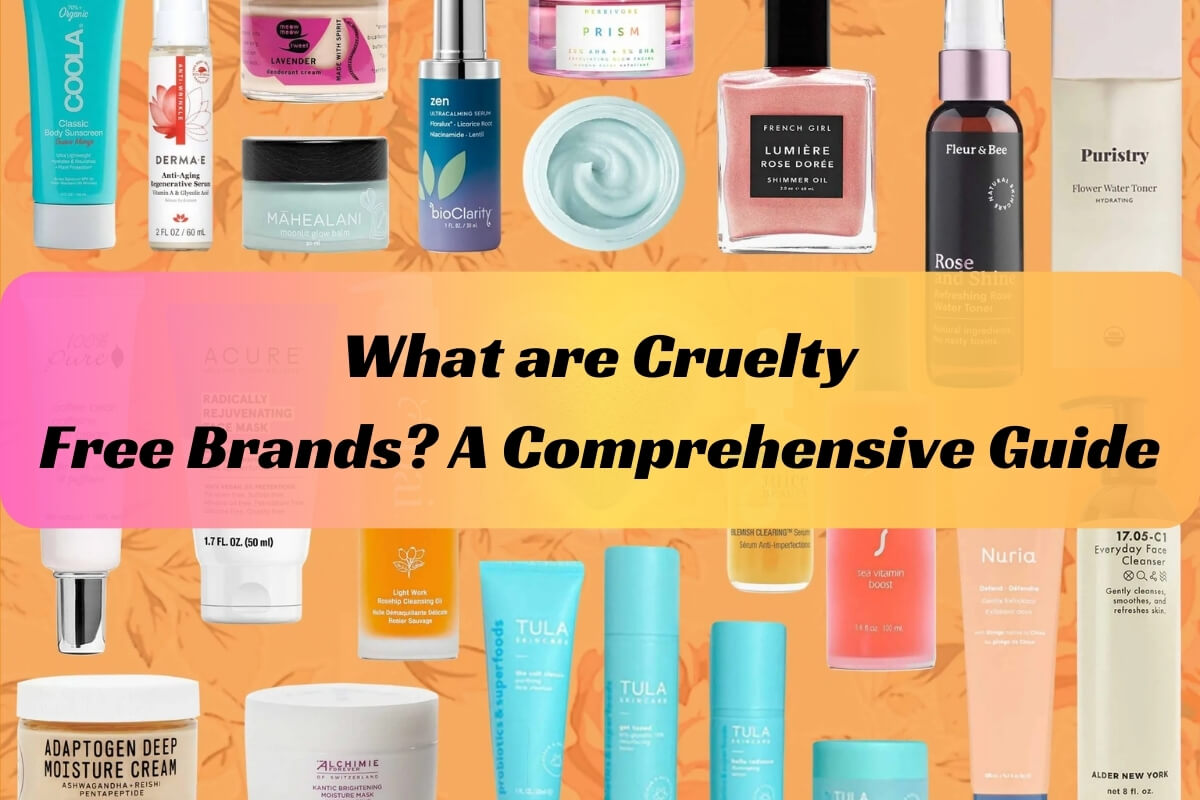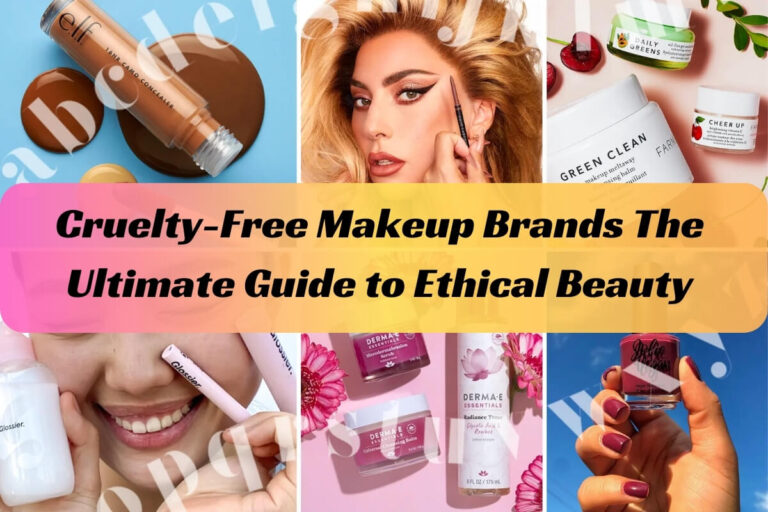What are Cruelty-Free Brands? A Comprehensive Guide

Cruelty-free brands are companies that do not test their products or ingredients on animals at any stage of development, production, or distribution. This guide will provide you with a thorough understanding of what it means to be cruelty-free, why it matters, and how to identify and support ethical brands that align with these values.
What Does It Mean to Be Cruelty-Free?
Cruelty-free is a term used to describe products and brands that are developed without any form of animal testing. This includes testing of individual ingredients, formulations, or finished products on animals. Cruelty-free companies follow ethical and compassionate practices that prioritize animal welfare.
To be considered truly cruelty-free, a brand must ensure that:
- No Animals Are Harmed: The brand itself does not conduct, commission, or allow animal testing at any stage of product development or manufacturing.
- Ingredient and Supplier Screening: All ingredients and raw materials used in the products are sourced from suppliers that do not test on animals.
- No Third-Party Testing: The brand does not hire or authorize any third-party entities to conduct animal testing on their behalf.
- Global Compliance: The brand’s cruelty-free policies apply worldwide, including in countries where animal testing is legally required for certain products.
Brands that meet these criteria prioritize alternative testing methods, such as computer modeling, cell cultures, and human clinical trials, to ensure product safety and efficacy without harming animals.
Why Choose Cruelty-Free Brands?
Choosing cruelty-free brands is not just about personal preferences – it has far-reaching implications for animal welfare and ethical consumerism. Here are some compelling reasons to support cruelty-free companies:
- Animal Welfare: By choosing cruelty-free brands, you are actively opposing animal cruelty and advocating for more humane practices in product development.
- Personal Values Alignment: For many consumers, cruelty-free products align with their ethical beliefs and allow them to make compassionate choices that reflect their values.
- Consumer Demand: As more people become aware of animal testing practices, the demand for cruelty-free alternatives continues to grow, encouraging more brands to adopt ethical policies.
- Environmental Consciousness: Many cruelty-free brands prioritize sustainable and eco-friendly practices, making them a more environmentally conscious choice.
By supporting cruelty-free brands, you can contribute to creating a more ethical and compassionate industry while promoting positive change for animals.
How to Identify Cruelty-Free Brands
With an increasing number of brands claiming to be cruelty-free, it can be challenging to separate fact from marketing claims. Here are some reliable ways to identify truly cruelty-free brands:
- Cruelty-Free Certifications: Look for reputable third-party certifications like Leaping Bunny, PETA’s Beauty Without Bunnies, and Choose Cruelty-Free. These organizations thoroughly vet brands’ policies and practices to ensure they meet strict cruelty-free standards.
- Brand Statements and Policies: Check the brand’s website, packaging, or marketing materials for clear and transparent statements about its cruelty-free policies and practices.
- Parent Company Policies: Research the brand’s parent company or conglomerate to ensure their policies align with cruelty-free standards. Some brands may be cruelty-free themselves but are owned by companies that still engage in animal testing.
- Online Resources: Consult trusted online databases and directories, such as Logical Harmony’s Cruelty-Free Brand List, PETA’s Cruelty-Free Company Search, and Leaping Bunny’s Compassionate Shopping Guide, to verify a brand’s cruelty-free status.
Brand policies and ownership structures can change, so it’s essential to stay vigilant and regularly check for updates.
Popular Cruelty-Free Brands Across Categories
As consumer demand for cruelty-free products continues to grow, more and more brands across various categories are embracing ethical and compassionate practices. Here are some popular cruelty-free brands to consider:
Makeup and Cosmetics
- Elf Cosmetics: A budget-friendly and 100% cruelty-free brand available at numerous retailers.
- Tarte Cosmetics: Known for their high-performance and eco-friendly makeup products.
- Pacifica Beauty: Offers a range of cruelty-free and vegan cosmetics and skincare products.
- Ilia Beauty: A clean beauty brand focused on ethical and sustainable practices.
Skincare
- Derma E: A pioneering brand offering affordable and effective cruelty-free skincare solutions.
- Youth to the People: Combines nutrient-rich ingredients with cruelty-free and vegan formulas.
- Herbivore Botanicals: A luxury skincare brand featuring plant-based and cruelty-free formulas.
- The Ordinary: Provides affordable and effective skincare products without animal testing.
Haircare
- DevaCurl: A renowned brand specializing in curl-enhancing and frizz-fighting hair products.
- Carol’s Daughter: A haircare line inspired by natural ingredients and cruelty-free practices.
- Briogeo: Offers a range of hair care products made with ethically sourced and cruelty-free ingredients.
- OGX: A popular drugstore brand with various cruelty-free hair care collections.
Bath and Body
- Lush Cosmetics: A pioneer in cruelty-free and sustainable bath and body products.
- The Body Shop: A well-known brand offering a wide range of cruelty-free and ethically sourced products.
- Dr. Bronner’s: A family-owned brand known for its iconic castile soaps and cruelty-free values.
- Puracy: A plant-based and cruelty-free line of bath, body, and household products.
This is just a small sample of cruelty-free brands. As demand grows, more options become available, making it easier to find ethical alternatives.
Cruelty-Free Brands to Avoid (Owned by Non-CF Companies)
While many brands proudly claim to be cruelty-free, it’s essential to be aware that some are owned by larger parent companies that may still engage in animal testing practices. In such cases, it’s up to individual consumers to decide whether they want to support these brands or avoid them.
Here are a few examples of cruelty-free brands owned by non-cruelty-free parent companies:
- Burt’s Bees (owned by Clorox)
- Aveda (owned by Estée Lauder Companies)
- Tom’s of Maine (owned by Colgate-Palmolive)
- Bare Minerals (owned by Shiseido)
- Urban Decay (owned by L’Oréal)
Some consumers boycott cruelty-free brands with non-ethical parent companies, while others support them to encourage change across the entire company.
It’s a personal choice based on individual values and beliefs. By being informed, consumers can make conscious decisions and contribute to more ethical and compassionate practices in the industry.
Myths and Facts About Cruelty-Free Beauty
As with any growing movement, there are several myths and misconceptions surrounding cruelty-free beauty products. Let’s address some of the most common ones:
Myth: Cruelty-free products are less effective or lower in quality.
Fact: Many cruelty-free brands use cutting-edge scientific methods and advanced ingredients to create high-performance and effective products without animal testing.
Myth: Cruelty-free products are more expensive.
Fact: While some luxury cruelty-free brands may be pricier, there are numerous affordable options available, from drugstore brands to online retailers.
Myth: Animal testing is necessary for product safety.
Fact: Modern alternative testing methods, such as in vitro (test tube) studies, computer modeling, and human clinical trials, provide reliable and accurate data without harming animals.
Myth: Cruelty-free brands cannot sell their products in certain countries.
Fact: While some countries may require animal testing for certain products, many cruelty-free brands choose not to sell in those markets to maintain their ethical standards.
Consumers can make informed decisions and support cruelty-free brands by knowing what’s true and what’s not.
Future of Cruelty-Free Beauty
The cruelty-free beauty movement is gaining momentum, driven by increasing consumer awareness and demand for ethical and sustainable products. As more people prioritize aligning their purchases with their values, the cruelty-free industry is poised for significant growth and innovation.
- Industry Trends and Growth: According to recent market research, the global cruelty-free cosmetics market is expected to grow at a substantial rate in the coming years. This growth is fueled by factors such as rising consumer consciousness, stricter regulations against animal testing, and the availability of advanced alternative testing methods.
- Innovation in Cruelty-Free Formulations: Cruelty-free brands are continuously pushing the boundaries of product development, exploring new ingredients, and leveraging cutting-edge technologies to create high-performance and efficacious formulations without compromising ethical standards.
- Increased Transparency and Accountability: With greater consumer scrutiny, brands are prioritizing transparency and accountability in their supply chains and manufacturing processes. This trend encourages more companies to adopt cruelty-free policies and gain third-party certifications to build trust with their customer base.
- Collaborative Efforts and Advocacy: Organizations, advocacy groups, and influencers are collaborating to raise awareness about cruelty-free beauty and encourage brands to embrace ethical practices. These collective efforts are driving positive change within the industry.
- Expansion into New Markets: As consumer demand grows globally, cruelty-free brands are expanding their reach into new markets, challenging traditional norms, and setting higher ethical standards for the beauty industry worldwide.
As the cruelty-free beauty movement continues to gain traction, it is not only transforming the industry but also influencing consumer behavior and societal attitudes towards animal welfare and ethical practices.
How to Transition to a Cruelty-Free Beauty Routine
Transitioning to a completely cruelty-free beauty routine can seem daunting, especially if you have been using the same non-cruelty-free products for years. However, with a little planning and patience, it is possible to make the switch gradually and effectively.
- Take Inventory: Start by going through your current beauty collection and identifying the non-cruelty-free products you own. This will give you a clear idea of what needs to be replaced and help you prioritize your purchases.
- Research and Build a List: Explore cruelty-free brands and products that can serve as replacements for your current favorites. Online resources, such as the Logical Harmony Cruelty-Free Brand List and PETA’s Cruelty-Free Company Search, can be invaluable in finding ethical alternatives.
- Replace Products as They Run Out: Instead of discarding perfectly good products, consider using up your non-cruelty-free items as they run out and replacing them with cruelty-free alternatives. This approach minimizes waste and allows for a more gradual transition.
- Prioritize Your Essentials: If you’re on a budget, prioritize replacing your essential or frequently used products first, such as foundations, mascaras, and skincare items. This will ensure that the products you use daily are cruelty-free.
- Find Cruelty-Free Dupes: Many cruelty-free brands offer dupes (dupes) or similar alternatives to popular non-cruelty-free products. Online communities and beauty influencers can be great resources for finding cruelty-free dupes that perform just as well as their non-cruelty-free counterparts.
- Be Patient and Flexible: Transitioning to a cruelty-free routine takes time and may require some trial and error. Be patient with yourself and flexible in trying new products and brands. Remember that every small step towards a cruelty-free lifestyle contributes to the greater cause of animal welfare.
Build a compassionate and ethical beauty routine by following these steps and staying committed to your values. This will help you make a positive impact.



